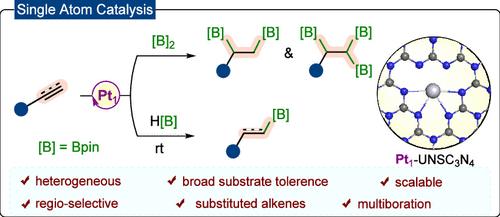Regioselective Multiboration and Hydroboration of Alkenes and Alkynes Enabled by a Platinum Single-Atom Catalyst
IF 13.1
1区 化学
Q1 CHEMISTRY, PHYSICAL
引用次数: 0
Abstract
Selective multiboration including di- and triboration and hydroboration of alkynes and alkenes face significant challenges in organic synthesis, including achieving high regioselectivity, functional group tolerance, and catalyst stability while requiring mild conditions to maintain reactivity. These transformations have been predominantly explored by using homogeneous catalysts. In this study, we report the scalable synthesis of heterogeneous platinum single-atom catalyst (Pt-SAC) supported on ultrathin nanosheets of graphitic carbon nitride via a rapid microwave-assisted method. The Pt-SAC enables 1,2-diboration of sterically hindered alkenes and 1,2,2-triboration of alkynes with B2pin2 under mild conditions. For the diboration of styrene, the catalyst achieves 99% yield with 95% selectivity, a turnover number (TON) of 3711, and a turnover frequency (TOF) of 247 h–1. The catalyst also promotes the regioselective hydroboration of alkenes and alkynes, yielding anti-Markovnikov alkylboranes and vinylboranes, respectively. Computational calculations reveal that the enhanced reactivity on the Pt-SAC catalyst arises from adsorption-induced weakening of key bonds (C=C and B–H), thereby significantly lowering the activation energy barriers. The Pt-SAC exhibits stability and recyclability, maintaining performance over at least eight consecutive runs without detectable Pt leaching. This study highlights the potential of Pt-SAC as a robust and versatile platform for organoboron transformations under mild conditions, with relevance to applications in pharmaceutical, agrochemical, and polymer synthesis.

铂单原子催化剂催化烯烃和炔的区域选择性多硼化和氢硼化
烷基和烯烃的选择性多硼化包括二硼化、三硼化和氢硼化在有机合成中面临着重大挑战,包括实现高区域选择性、官能团耐受性和催化剂稳定性,同时需要温和的条件来保持反应性。这些转化主要是通过使用均相催化剂来探索的。在这项研究中,我们报道了通过快速微波辅助方法在超薄氮化碳纳米片上可扩展合成非均相铂单原子催化剂(Pt-SAC)。Pt-SAC可以在温和的条件下实现位阻烯烃的1,2-二硼化和炔烃与B2pin2的1,2,2-三硼化。对于苯乙烯的裂解,该催化剂的收率为99%,选择性为95%,周转率为3711,周转率为247 h-1。该催化剂还促进了烯烃和炔的区域选择性硼化反应,分别生成了反马尔可夫尼科夫烷基硼烷和乙烯基硼烷。计算结果表明,Pt-SAC催化剂上反应活性的增强是由于吸附引起的键(C=C和B-H)的减弱,从而显著降低了活化能垒。Pt- sac表现出稳定性和可回收性,在至少连续8次运行中保持性能,没有检测到铂浸出。这项研究强调了Pt-SAC作为温和条件下有机硼转化的强大和通用平台的潜力,与制药,农化和聚合物合成的应用相关。
本文章由计算机程序翻译,如有差异,请以英文原文为准。
求助全文
约1分钟内获得全文
求助全文
来源期刊

ACS Catalysis
CHEMISTRY, PHYSICAL-
CiteScore
20.80
自引率
6.20%
发文量
1253
审稿时长
1.5 months
期刊介绍:
ACS Catalysis is an esteemed journal that publishes original research in the fields of heterogeneous catalysis, molecular catalysis, and biocatalysis. It offers broad coverage across diverse areas such as life sciences, organometallics and synthesis, photochemistry and electrochemistry, drug discovery and synthesis, materials science, environmental protection, polymer discovery and synthesis, and energy and fuels.
The scope of the journal is to showcase innovative work in various aspects of catalysis. This includes new reactions and novel synthetic approaches utilizing known catalysts, the discovery or modification of new catalysts, elucidation of catalytic mechanisms through cutting-edge investigations, practical enhancements of existing processes, as well as conceptual advances in the field. Contributions to ACS Catalysis can encompass both experimental and theoretical research focused on catalytic molecules, macromolecules, and materials that exhibit catalytic turnover.
 求助内容:
求助内容: 应助结果提醒方式:
应助结果提醒方式:


